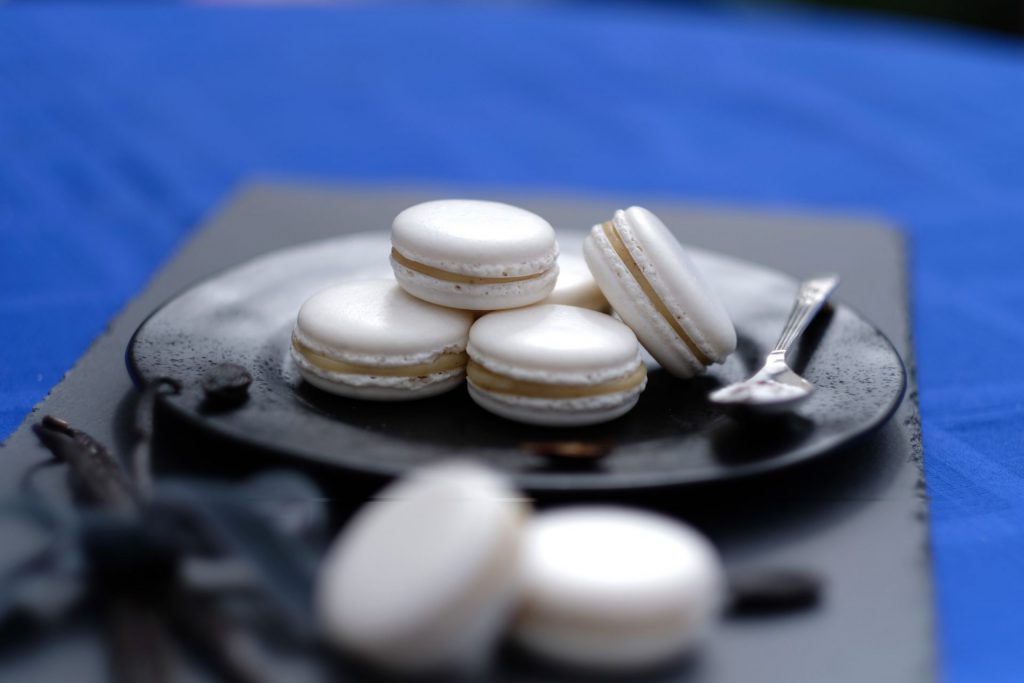French Macarons, Products
The best Vanilla Macarons
The History of Vanilla
Vanilla pods were first harvested, centuries ago, from wild orchids in Mexico. It was soon realized that, when they fell to the ground when they were barely ripe, the long, thin fruits of these plants fermented under a covering of humus, giving off an exquisite aroma. The first mention of vanilla can be found in the Chronicles of the Aztec ruler Itzcoalt (1427-1440).
The Aztecs knew how to prepare it so that the spice would retain its aroma and they had probably used it for centuries in the preparation of cocoa drinks, in order to soften the bitterness. In the Aztec language, vanilla was called “tlilxot chitl”, which means “black pod”. It would take more than a century for a European to give it a name with a Latin sound, pronounceable for the West.
It was Christopher Columbus who brought it back to our continent: during his third trip to “India” in 1518, his Spanish conquistador Hernán Cortès brought the first Mexican vanilla plants to Europe.
According to the testimony of an officer, when Hernán Cortes and his soldiers entered the city of Tenochtitlan, later to be called Mexico City, the Aztec emperor Montezuma allegedly offered them a vanilla chocolate drink in gold cups. Vanilla pods could also be found among the jewellery and feather trimmings. Pre-Columbians used vanilla as a diuretic and depurative and attributed aphrodisiac and healing virtues to it.
For more than two centuries, Mexico maintained a monopoly on vanilla cultivation: all attempts to produce this orchid outside its original natural area ended in failure, largely due to fertilization problems as we will see later. Although Madagascar has now become a leading producer of vanilla, for me, the fragrant flavour of Mexican vanilla is still the best; it was the original, after all!
Until the 19th century, it was not known that it was a species of bee specific to Mexico that played the essential role of fertilizer in the formation of its fruit. It took botanists several years to realize that for vanilla, the male and female flower organs were separated by a waterproof membrane called “rostellum”.It was only in 1836 that the Belgian botanist Charles Morren discovered the artificial pollination of orchids. A few years later, in 1841, on the island of Reunion, in the Indian Ocean between Madagascar and Mauritius, a twelve-year-old Bourbonnais slave, Edmond Albius, managed to find a way to replace the Mélipone bee. His method was so simple that it is still in use today: each flower must be fertilized manually, one by one!


The vanilla vine and different types
From a botanical point of view, vanilla is a monocotyledon of the orchid family. Unlike many other orchids that are popular with ornamental plant lovers, this one produces small flowers of limited aesthetic interest.
Vanilla is a climbing vine. It clings to trees with its roots to reach better light conditions. However, it is not a parasitic plant but an epiphyte (i.e. a plant that uses another tree as a support to grow).
I am talking here about “vanilla”, but it would be more accurate to talk about “vanillas”. Indeed, more than 110 species of vanilla have been recorded to date. However, despite this great diversity, commercial cultivation is essentially based on 2 species:
Vanilla planifolia, which is undoubtedly the best known, is the most sold species and is the type grown in Mexico (see photo above) whereas Tahitian vanilla (Vanilla tahitentis) is less well known.


Mexico’s precious gift to the world!
The most rich and authentic vanilla grows in the state of Veracruz, Mexico, near the Gulf of Mexico. It takes approximately 18 months for a vanilla cutting to produce its first flowers which are small and yellowish green. The pollinated orchid will produce a long green bean (pod) in a few weeks, but the bean must remain on the vine for about nine months to be able later to develop its complex flavour and fragrance profile. When the beans are harvested, they actually have neither flavour nor fragrance until they go through an arduous curing and drying process.
Methods of curing and drying vary, but in all cases, the enzymatic process in the live beans must be halted to prevent fermenting. This is accomplished through heating in ovens or blanching in hot water. The beans are then placed in the sun each morning for weeks, or sometimes months, before being placed in large wooden boxes and allowed to sweat. The beans will lose nearly 80% of their original moisture content before their more than 250 natural flavour and fragrance components are completely developed. The entire process from pollination to shipment takes about a year.
When you consider the extensive labour required to grow, harvest, and cure the pods it’s not surprising that vanilla is the world’s second most expensive spice (after saffron).
Mexican Marvels
In our macarons, the Mexican vanilla provides a very soft, gentle taste. Its milky, rounded, sweet flavour reassures us. It offers us a return to childhood from the first taste. How could you not love it?



